
Cold email outreach is an effective way to increase sales and boost your bottom line. In fact, the average open rate for cold emails is an impressive 24%.
The reason why businesses see so much success using cold email outreach is because it drives big results:
👉 The average unsubscribe rate from cold emails is only 0.17%.
👉 Cold emails generate a return on investment of up to 4400% more than any other channel.
👉 Sending cold emails to multiple prospects from the same email address increases reply rates by 93%.
👉 75% of cold emails are opened within one hour of them being sent.
However, cold email outreach can be a challenging marketing tactic to use in your business. In a world where inboxes are already crowded, getting your email to stand out from the rest can be hard.
In this article, we’ll guide you through the best strategies to get your cold emails noticed in cluttered inboxes. We’ll also share what you should avoid to ensure your cold emails are a success.
Keep reading to learn more!
What is Cold Email Outreach?
Cold email outreach is the process of reaching out to potential customers who are not aware of your brand or even the product or service you offer but are likely to buy from you.
This is one of the best types of cold outreach tactics because it is not as intrusive as other methods, like cold calling for example.
Cold emails sent to the right people at the right time may bring hundreds of new customers to your business.
Having an effective cold outreach strategy in place can be a game-changer for your business. It can help you:
- Expand your business and acquire more customers.
- Reduce customer acquisition costs (CACs).
- Improve brand awareness and affinity.
- Improve your sales conversions and, ultimately, your bottom-line profits.
- Expand your customer base to accommodate varied user personas.
Apart from business-to-business (B2B) sales, you can also use cold outreach for:
- Finding new business partners or professional networking.
- Search engine optimization (SEO) activities such as link-building.
- Recruitment campaigns to find the right candidates.

Is Cold Email Outreach the Same As Email Marketing?
Cold emailing and email marketing are two different approaches to reaching out to potential customers.
The key difference is that with cold emailing, you don’t have an existing relationship with the person you’re contacting. With email marketing, there is already a relationship in place between your brand and the recipient.
Let’s look at some of the differences between cold email outreach and email marketing:
🏆 Goals
The aim of cold emailing is to establish initial contact with an individual to generate leads. On the other hand, email marketing aims to build on existing relationships with potential customers and ideally drive conversions and sales.
🕙 Frequency
In cold emailing, the amount of emails you send to a single recipient is quite high, especially due to the number of follow-up emails required. We’ll discuss follow-up emails in more detail later in this article.
In email marketing, the number of emails sent depends on how frequently you want to engage with potential and existing customers with your marketing message. This is usually one to two emails per month.
📈 Metrics
In email marketing, the focus is on:
- Open rates.
- Click-through rates.
- Conversion rates.
- Revenue generated.
In cold emailing, the focus is more on:
- Deliverability rates.
- Response rates.
- Engagement rates.
- Click-through rates.
🔧 Tools
When it comes to email marketing, you use tools to manage subscriptions, create email content, and analyze your campaign performance.
Cold email automation tools are designed to find prospects, build email lists, verify email addresses, and follow-ups.
For small teams or solo founders looking for a lighter touch, a simple email marketing platform can help you write more personal messages, discover new leads with its AI lead-finder, and schedule follow-ups without a steep learning curve.
Does Cold Outreach Work in 2024?
Cold outreach works in 2024, provided you have an updated strategy.
Targeting the right people, personalizing strategies to cater to the prospect’s needs, and experimenting with different types of email content are some outreach strategies that work today. We’ll share more about these strategies later in this article.
Some strategies don’t work, however. These include:
- Cold emailing contacts that are picked randomly from a directory.
- Using the same email template or script for pitching all potential clients.
- Sticking to one or two outreach channels and not experimenting with new channels.
- Not setting key performance indicators (KPIs) and measuring the right metrics for your cold outreach campaigns.

The Benefits of Cold Email Outreach
Now that you know that cold email outreach does work, let’s look at the benefits of using this tactic within your business:
✅ Cost-effective
Compared to other marketing strategies, cold emailing is typically inexpensive. You don’t need a large budget to reach potential leads like you would with paid advertising, for example, which requires a significant budget to get right.
Additionally, you don’t have to invest in an expensive outreach tool if you can’t afford one—manual cold emailing can still be effective.
✅ Scalability
You can reach large audiences via cold email. You can send hundreds or even thousands of emails at once, and you can scale your efforts up or down based on your needs and goals.
✅ Measurable results
Cold email campaigns provide clear metrics such as open rates, click-through rates, and response rates. These insights can help you measure the effectiveness of your outreach efforts and make data-driven adjustments to your campaigns.
For example, if you see that your response rate is low when you send emails in the evening, you know you need to adjust the timing and scheduling of your cold emails to get better results.
✅ Versatility
Cold emails can be used for many different reasons, not just sales. They can be used to develop partnerships and recruit new talent, for example. The flexibility of cold emails makes them a valuable tool for different types of outreach.
✅ Time-efficient
Once you have a well-crafted email template—more on this later—you can reach out to many prospects without spending much time on this marketing activity. This is especially true if you use cold email automation tools.
✅ Highly targeted
Using cold emailing means you can get highly specific in the people or businesses you’re targeting. You can also tailor your email outreach to each individual, potentially increasing your chances of a successful campaign.
✅ Better return on investment (ROI)
Emailing can provide a better ROI compared to other cold outreach methods. This is because you don’t have to spend much money on this marketing activity, and it may yield huge results.
18 Effective Cold Outreach Strategies That Work in 2024
Now that you know how beneficial cold email outreach is, let’s have a look at some techniques that will make your efforts effective:
1. Start with a cold email campaign strategy
The first step to getting cold email outreach right is to have a strategy in place. Without a strategy to guide you, your efforts will be directionless.
Your cold emailing strategy should include:
- Your target audience: These are the specific people you want to reach—more on this shortly.
- Your goals and objectives: You’ll need to outline what you want to achieve through your campaign clearly. This could be generating leads, setting up meetings, or getting referrals.
- Your content pillars or topics: Are you aiming to educate and inform your prospects? Or do you want to establish credibility and trust? These factors will impact the types of content you include in your cold emails.
- Your timing: When will you schedule your emails to be sent out? And how many follow-up emails will you be sending? How regularly will you send emails to your prospects as part of your campaign? These questions will help you establish the timing of your campaign.
- A competitor analysis: Thoroughly analyze what your competitors are doing in their cold outreach campaigns. This can help you identify opportunities where you can differentiate your approach.
- What problems you solve: You need to clearly understand what problems your product or service solves for your customers. What are their pain points, and how does your solution address them? This will help you create a value proposition in your cold emails that convince prospects they need your offering.
Now that you’ve developed a solid strategy, you can follow the rest of the tactics on this list.
2. Reach out to the right people
While implementing cold outreach campaigns, reaching out to the right people is crucial. If you get this step wrong, hitting your campaign’s KPIs will be difficult.
The first step would be to draft your ideal customer profile (ICP). You can do this through market research, competitor analysis, and surveying your existing customers.
Next, you’ll want to build a database of people who closely match your ICP. It can be tricky to ensure both accuracy and protection, but leveraging a specialized tool like PowerDMARC can make all the difference. As a cloud‑based email authentication platform, PowerDMARC helps you manage DMARC effortlessly—complete with AI‑powered threat intelligence, real‑time alerts, and encryption for forensic reports—so your efforts remain both targeted and secure. Their DMARC record checker helps in getting 100% accurate results about your DNS record’s validity and settings within seconds, and increases the deliverability of your legitimate emails.
Whatever cold outreach channel you use, we believe the best way to find these people is via a LinkedIn search. Alternatively, you can use tools like Hunter Discover that help you identify B2B leads quickly, along with their accurate contact information that you can use for later cold outreach.
Both the free and premium versions of LinkedIn offer various search filters that will help you fish out your target audience.
Learning to use LinkedIn boolean search operators can provide a lot of assistance with this first step. These are the types of results LinkedIn’s boolean search operators provide:
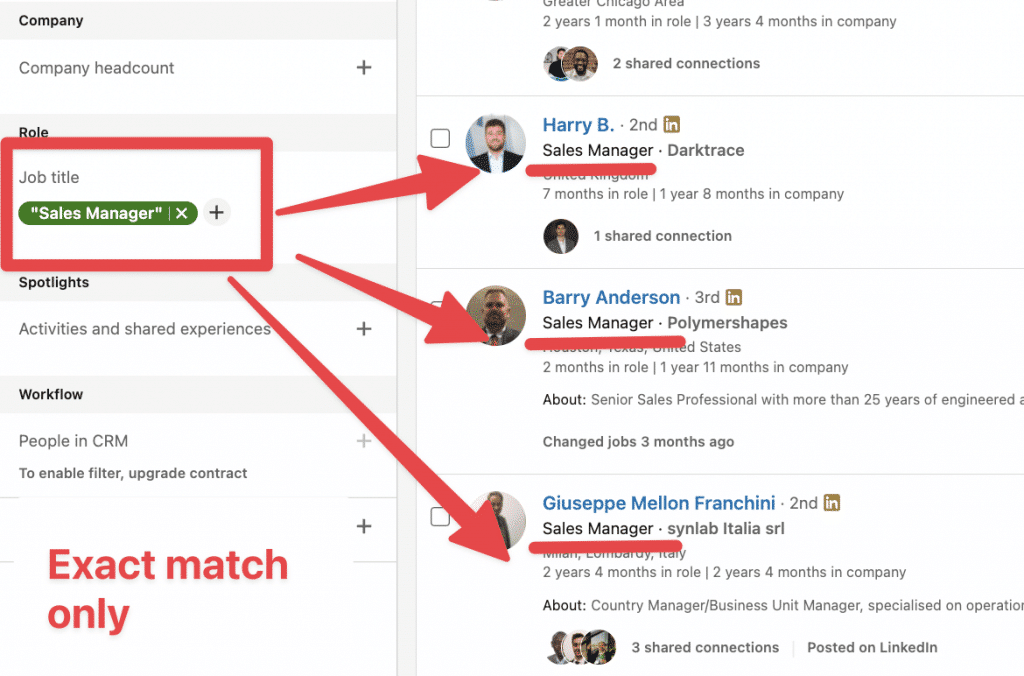
3. Pay attention to your subject line
Your email subject line is the first thing prospects see when they receive your message. For this reason, it has to be good. You must give the recipient a reason to open and read your message, and this starts with the right subject line.
In fact, 33% of email recipients decide whether to open an email based on subject lines alone.
Here are some guidelines for crafting a compelling subject line for your cold emails:
➡️ Keep them short
You need to ensure your cold email subject lines are between 40 and 50 characters. Longer subject lines may be cut off by the prospect’s email client—like Gmail or Outlook. This is especially true on mobile devices. If your subject line is cut short, it may reduce its impact.
Some examples of short cold email subject lines are:
- Let’s talk about [topic/idea]
- A [better/faster/smarter] way to [reach a specific goal]
- Free to talk [date]?
➡️ Use personalization
Personalized subject lines increase average email open rates by 50%. By including the prospect’s name, their company name, or their job title, you’re creating a great first impression with your subject line.
A personalized subject line can make your prospect feel valued versus a generic subject line that treats them as just another consumer.
Examples of personalized subject lines for your cold email outreach include:
- A solution tailored for [company name]
- Let’s discuss [prospect’s project or goal]
- Exclusive offer for [company name] only
➡️ Include the pain point
When you develop your strategy and outline your ICP, you will have uncovered their main pain points. Including this problem in your subject line is another effective strategy to get prospects to open your email.
Some examples could be:
- This is your final chance to solve [pain point]
- Stop wasting resources on [pain point]
- Your [pain point] issues resolved
4. Provide the recipient with something of value
Although cold emailing aims to sell your product or service, your goal should be to provide the prospect with as much clear, tangible value as possible.
Your email could educate or inform them about a topic that interests them. You may want to provide them with solutions to their problems through a blog post. Or you could offer them free trials or demos of your products that they wouldn’t receive anywhere else.
Another option is to share insights or industry trends and recent developments that could impact the recipient’s business. You could also share best practices and tips that are relevant to their work or industry.
Cold outreach emails that provide the reader with value are more likely to resonate with them and elicit positive responses.
5. Carefully consider your email content
As your cold email is likely your first interaction with a prospect, it’s important to ensure you create a good impression.
The content you include in your email can help you look professional and establish credibility, boosting your cold email outreach efforts.
➡️ Keep it concise
You’re likely targeting decision-makers in businesses through your cold email outreach, as these individuals would purchase your product or service. People receive hundreds of emails daily, and decision-makers likely receive even more.
Lengthy emails with large chunks of text can be overwhelming and off-putting for your prospects.
For this reason, your email needs to be concise and easy to read. This captures the reader’s attention and ensures they’ll read your entire email—and, ideally, take action.
Focus on the message you want to convey and ensure you present your main point quickly.
You can also format your email so that it is easy to read by using visuals to break up batches of text, for example.
Here’s an example of a concise cold outreach email:

➡️ Use the appropriate tone
The tone you use in your email content should be consistent with the language you use across all your marketing channels and materials. This ensures your business is recognizable and creates brand awareness.
Another reason to use the right tone is that you want to convey professionalism and respect in your email. Your tone sets the stage for how the recipient perceives your business and impacts their first impression.
A respectful and considerate tone shows that you value the reader’s time, which is essential when reaching out to someone for the first time.
Lastly, an authentic and genuine tone helps you build trust and rapport, which is a big goal for cold email outreach. Recipients are more likely to respond positively to a brand that seems real and sincere rather than overly formal or casual.
➡️ Consider your structure
You want to draw your prospects in right from the start of your email. It’s a good idea to structure your email content in a way that conveys your main message first.
Next, you’ll want to ensure your email follows a logical flow rather than jumping from one point to another.
Lastly, make sure you emphasize the most important points throughout the message to ensure the reader doesn’t miss out on any crucial details.
➡️ Create a sense of urgency
Crafting emails that convey a sense of urgency can prompt your prospects to take action faster, increasing the likelihood of a positive response.
A sense of urgency creates a psychological trigger that motivates the reader to prioritize your email over others.
You can create urgency by offering:
- Limited-time discounts.
- Early bird offers.
- Limited availability.
- Specific dates.
- First-come, first-served.
- Special access.
You should include this offering in both your subject line and in your email content.
➡️ Provide a soft close
A soft close in cold emails is important because it makes the recipient feel more comfortable and less pressured. This increases your chances of engagement and having them take action.
If you’re asking prospects to book a call or meeting with your team, you can close off your email by offering a couple of time slot options and ask if any of them work for the recipient.
This fosters a sense of openness and willingness to engage and avoids appearing too pushy or aggressive.
6.Use cold email templates
Developing a good cold email template helps you save time and resources. This is because you only need to create the email once, and then you can use an automation tool that will fill in the personalization fields—like the recipient’s name—automatically.
| ⭐️ Where to Find Good Cold Email Templates Our team of experts has compiled an entire guide that includes multiple cold email templates that you can use within your business to save time and resources. Check out our full guide on cold email templates to learn more. |
7. Don’t forget to include your contact details
Although the person receiving your cold email will naturally have your email address, it’s a good idea to include other ways they can contact you within your email content.
Providing your social media links, phone number, or support center details can help readers contact you in the way they are most comfortable with. It also creates credibility and professionalism.
8. Ensure you optimize for mobile
Almost two billion people read their emails on mobile devices. It’s important that your cold emails are optimized for mobile.
Your templates should be responsive, meaning they automatically adjust to different screen sizes. This ensures your email looks good on both mobile and desktop.
You’ll also want to ensure that any visual elements you include in your email scale properly to fit various screen sizes to prevent distortion and pixelation.
| 💡 A Tip From Our Experts: Your Fonts Matter Fonts are also important when it comes to optimizing cold emails for mobile devices. Use a minimum font size of 14px for body text and 22px for headlines to ensure readability on smaller screens. Choose clean, easy-to-read fonts that are legible on any screen. |
9. Embrace personalization
Your prospects are bombarded with sales pitches all day. Our brains are naturally wired to filter everything out, except when we find offers that speak specifically to us. This is called personalization.
Personalizing your cold outreach campaigns can drastically improve your conversions throughout the customer journey.
Studies show that more than 90% of consumers in the U.S. find personalization appealing.
Personalizing your cold outreach with the recipient’s first name, job title, and company name is a common way to personalize your messages. However, if you want to take it a step further, image personalization is a must-try.
Hyperise is a powerful image-personalization toolkit that helps you dynamically personalize images, GIFs, and videos. Personalized images can help you improve your conversions by up to three times.
Here’s one example of how you can use our toolkit to personalize an image for your cold emails:
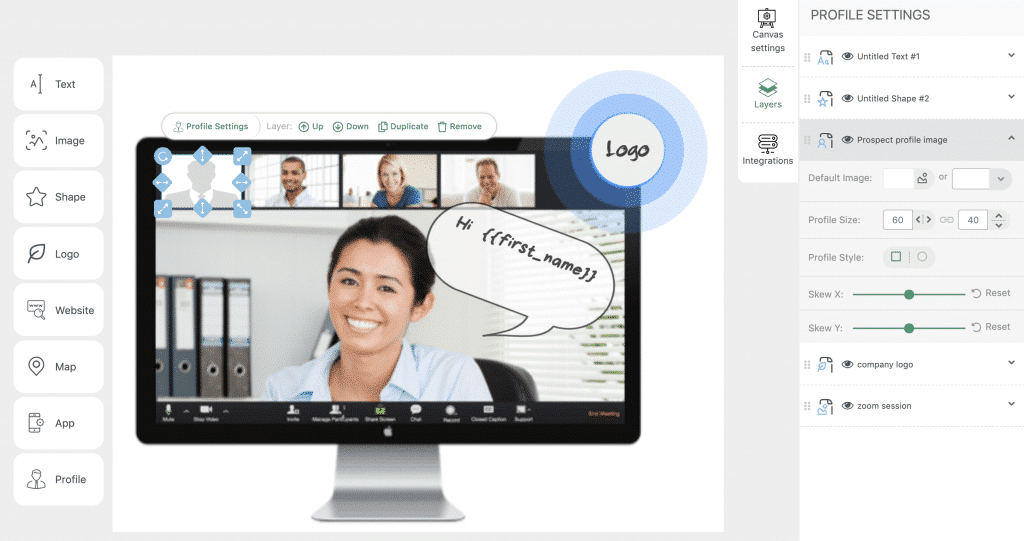
10. Ensure that your messaging is right
An essential piece of the cold outreach puzzle is getting the messaging right. You must meet the prospect exactly where they are in their customer journey. You should be able to talk about their pain points and offer solutions that exactly cater to their needs.
Using the problem-agitate-solve (PAS) formula in your sales pitches can be a surefire way to entice your prospects.
You can do this by discussing the prospect’s pain point, outlining their agitation, and presenting your offer as a solution to their problems.
Here’s an example of a cold outreach email that uses the PAS formula to entice prospects and encourage them to read the full email:
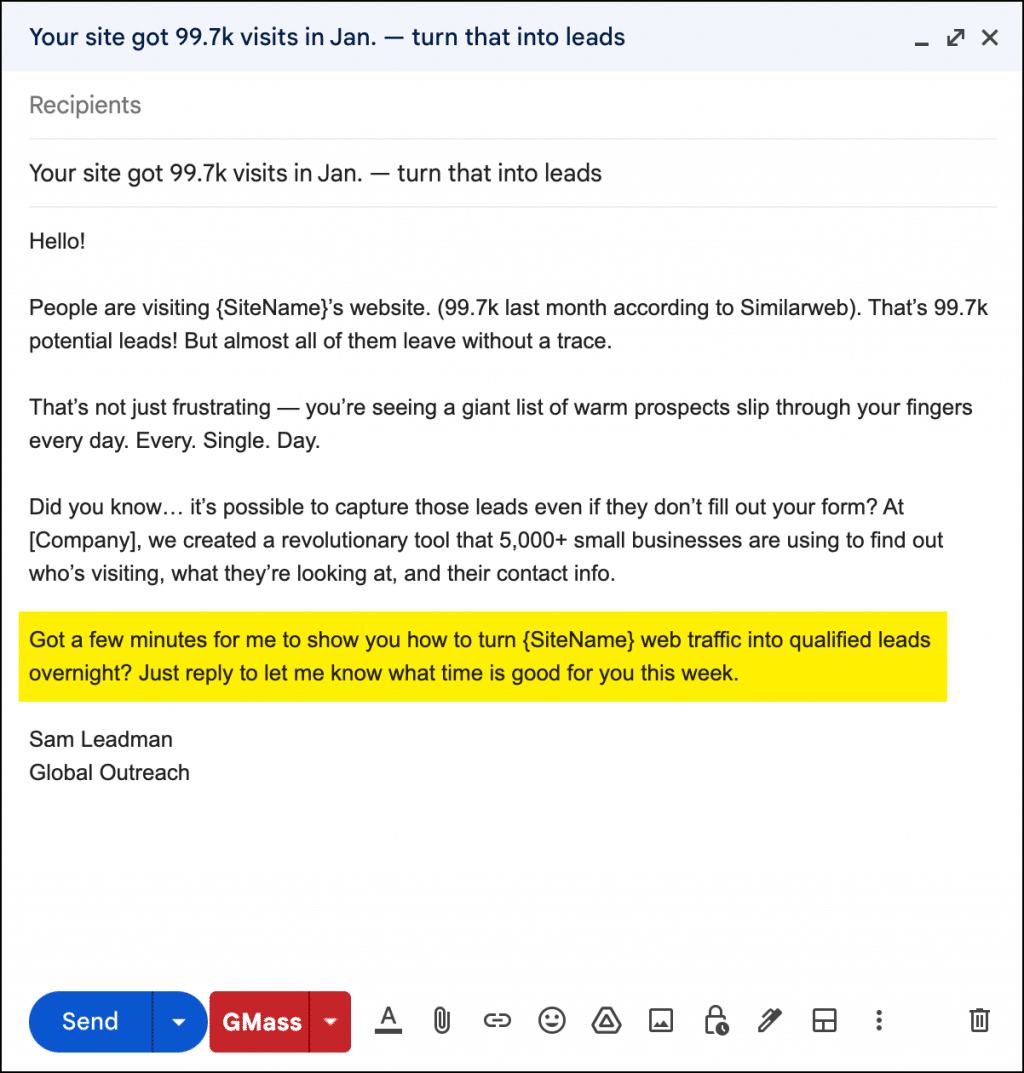
11. Establish credibility
For a prospect to respond to your outreach message and give you their limited attention, you must build trust with them. And the best way to do so is by using elements throughout your email that display credibility.
Coming across as an expert and thought leader in your niche is necessary for all cold outreach channels.
You can establish credibility and build trust by showcasing different types of social proof, like testimonials, customer ratings, reviews, case studies, and trust badges within your email content.
Here’s an example of a cold email that uses customer testimonials as social proof to build credibility for their brand:

12. Use a strong call-to-action (CTA)
The purpose of your cold email is to get the recipient to take action. Whether that’s booking a call with you, attending your webinar, or signing up for a free trial of your product.
However, if you don’t make it clear for the reader as to what action they should take, you likely won’t get any leads or sales.
You should include a strong call-to-action (CTA) within your email to drive the recipient to take action based on what you’re saying.
This could be in the form of CTA buttons placed strategically throughout your email or including links to where you want the reader to go next.
Here’s a good example of a strong call to action in a cold email from Dovetail:
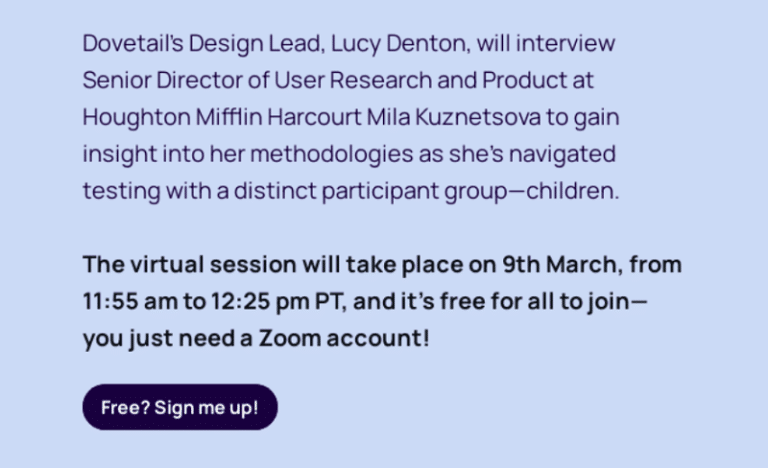
13. Add a professional email signature
One tactic that works well in cold email outreach is to send your emails from a sales representative’s account. When the prospect receives the email, it looks like it comes from a real person, which can go a long way in building a relationship with a new lead.
If you’re going to implement this approach into your strategy, it’s a good idea to include a professional signature at the end of your cold email.
A professional email signature includes:
- The name of your company.
- Your company logo.
- The contact details of the sales representative contacting the prospect.
- A profile photo of the sales representative.
You may also want to include clickable social media links in your email signature.
Here is a good example of a professional signature that could be included at the end of a cold email:
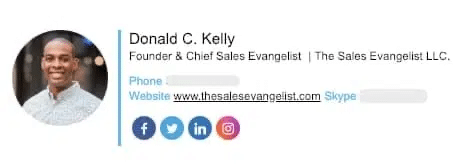
14. Invest in the right tools
The more people you reach out to with personalized messages, the better chance of success. However, scaling your cold outreach campaigns using personalization can be difficult.
However, choosing the right tools can help you scale your campaigns effectively. Tools can help you reach out to more people and help you with other aspects of your campaign. You can use them to track campaign metrics, perform A/B testing, implement personalization, store lead data, and save time.
Hyperise is one of the best image and video personalization tools. You can use this for your sales emails, LinkedIn outreach, or other social media channels.

Hyperise also offers integrations with most email tools, customer relationship management (CRM) software, and LinkedIn automation tools, making it super convenient to use.
You can also use email marketing tools such as Outreach.io, Lemlist, Prospect.io, Quickmail, Woodpecker, and Snov.io for cold email campaigns. You can also use tools like Hunter.io to find email addresses and verify them.
CRM tools can help you manage cold outreach campaigns and track metrics from a single platform. You can use it to store the contact information of your email subscribers, identify social selling opportunities, and optimize your marketing campaigns.
CRM tools such as Active Campaign, Hubspot, Keap, and EngageBay are great for managing all your email data on one platform.
In addition to personalization tools, leveraging editpad summarizing tool can enhance your cold outreach efforts. When researching potential leads, you may encounter lengthy articles, reports, or profiles. Editpad.org’s summarizing feature allows you to condense these documents quickly, enabling you to extract key insights without spending excessive time reading. This efficiency allows you to craft more informed and personalized outreach messages.
15. Proofread your cold emails
Nothing will detract from your credibility like spelling and grammar errors. Ensure your cold emails are proofread before sending them to your prospects.
Have a colleague read through your cold emails to spot any mistakes you might have missed. You may also want to hire a freelance proofreader from a platform like Fiverr to take a look at your email templates before you start using them.
If you’re working hard to craft good cold emails, don’t let your efforts go to waste by sending emails with mistakes that make you look unprofessional and less credible.
16. A/B test your campaigns
No marketer can predict the best possible channel, messaging, and offer for your cold outreach campaigns. Extensive testing is the only way to improve your cold email outreach campaign metrics.
A/B testing—also known as split testing—allows you to test different elements of your outreach campaigns one at a time. This can help you significantly improve your sales conversions while reducing customer acquisition costs.
For example, you can A/B test different email subject lines, calls to action, images, and offers.
Here’s a breakdown of how you could A/B test different subject lines for your cold emails:

17. Measure your campaigns
Implementing cold outreach without measuring your campaigns would be a waste of resources. If you don’t know how your cold email campaigns are performing, how will you know what to improve?
There are many different KPIs that you can set for your cold outreach campaigns, including:
- Open rates.
- Deliverability rates.
- Meeting conversion rates.
- Response rates.
- Lead conversion rates.
Of course, the KPIs you set will vary depending on the overall campaign goals you outlined in your strategy.
18. Don’t forget to follow up
Following up is an essential part of sales outreach.
A software product called Ambition used cold emailing to target 578 prospects. Initially, they only got six responses. However, once they started sending out follow-up emails, they got an additional 67 responses—resulting in a response rate of around 12.6%.
When you first reach out to a prospect, there may be a lot of reasons why they may not respond immediately.
A follow-up email, phone call, or message helps you get a second chance at pitching your product or service.
Following up also helps you determine if you should stop contacting a lead. You’re more likely to get a yes or no response when you follow up multiple times.
Using a cold email tool, you can set up automated follow-ups so that these emails get sent without you having to do the work yourself.
Cold Email Outreach Mistakes to Avoid
After putting time and effort into your cold emails, the last thing you want is for them to land in the recipient’s spam folder. There are several things you need to avoid if you want your cold email outreach campaign to work:
❌ Lack of personalization
As mentioned earlier, personalization is one of the best tactics to use when sending out cold emails. Recipients can quickly spot generic emails that haven’t been tailored to them specifically. And they’re more likely to ignore these—meaning you won’t get any engagement at all.
At the very least, you should include the recipient’s name and company name in your email to personalize it.
Of course, you can go one step further and use the Hyperise editor to generate personalized email content that will boost your engagement rates exponentially.
❌ Emails that are too long
The individuals you’re emailing don’t have time to read lengthy emails. Additionally, attention spans are shorter today than they used to be. If you want your cold emails to be read (and for recipients to take action), they must be short and concise.
Keep your email to the point, focusing on one message. Try to avoid long, seemingly endless paragraphs. Rather, use short sentences and paragraphs that are easy for the reader to skim through.
You may also want to use bullet points and headings to make your email content easier to digest and understand without the reader having to spend much time reading the message.
❌ Lack of a clear CTA
Sending a cold email has a specific purpose. There’s an action you want the recipient to take. If you don’t guide them toward taking action, the reader will likely do nothing after reading your cold email. In fact, they may forget about you reaching out entirely.
Your calls to action should be clear, compelling, and easy to spot if you want your recipient to act on your email.
❌ Not researching the recipient
This may be harder to do when sending emails on a larger scale, but failing to research your recipients can lead to sending them irrelevant information that isn’t appropriate to them.
You need to understand who your recipients are, what they do, and how you can make your cold emails relevant to them.
This is why having a strategy in place for your cold email campaigns is vital. In your campaign’s strategy phase, you get to know your target audience so you understand what will resonate with them most.
❌ Spelling and grammar errors
Spelling and grammar mistakes create an unprofessional image for your brand. They also take away from your credibility. Your email should be completely error-free before you hit the send button.
❌ Using the wrong language
If you’re in the B2B space and you’re sending cold emails to decision-makers in organizations, your language needs to be appropriate to this. Maintain a professional tone throughout your cold emails, and avoid using slang or overly casual language.
It’s important to remember that while your prospect may be well-educated, they may not understand the jargon relevant to your industry, product, or service. Ensure you keep your language plain and easy to understand.
❌ Sending your emails at the wrong time
The time of day that recipients receive your emails impacts how well your campaign will perform. If you want to ensure your emails are open and read, you need to research when your target audience is most likely to read their emails.
| 💡 A Tip From Our Experts: The Best Time to Send Cold Emails The best time of day (and day of the week) to send cold emails will vary depending on your target audience and industry. But our experts recommend sending cold emails mid-morning (around 10 to 11 am). Ensure you avoid late evenings and early mornings, as emails sent at this time are less likely to be seen promptly. It’s important to know your target audiences’ time zones. You need to ensure your emails reach your prospects at the same time of day around the world. Schedule your emails to arrive at the right time, no matter the recipient’s time zone. |
❌ Not providing value
Sending purely promotional emails that only sell your product or service (and nothing else) likely won’t be received well. You should prioritize providing prospects with clear value. You need to give them a good reason to engage with your email.
You can do this by providing a useful resource or guide. You could also provide them with a data-driven report or e-book that could help them.
❌ Ignoring compliance regulations
Ensure that your cold emailing practices comply with the relevant laws and regulations where your prospect lives. For example, some regulations require you to include an unsubscribe link or button in your email.
| 🤔 Is It Legal to Send Cold Emails? Sending cold emails is legal. However, this depends on the laws and regulations of the specific region or country that the recipient is in. In the U.S., there is the CAN-SPAM Act, which sets out the requirements for cold emails. These requirements include creating clear opt-out options for recipients to choose not to receive your emails. Failing to comply with acts like CAN-SPAM could lead to costly penalties for your company—not to mention a damaged reputation. |
❌ Being too pushy
Although you are reaching out with the intention of making a sale, you shouldn’t make your cold emails too aggressive. This can be off-putting for your prospects, leading to them not engaging with you.
Ensure you respect the recipient and provide them with value rather than pushing too hard for a sale.
Other Types of Cold Outreach to Try
Now that you’ve read our top strategies for cold email outreach let’s look at some other types of outreach that you could use within your business:
1. Cold calling
Cold calling is one oldest cold outreach marketing strategies. Cold calling worked even when mobile phones did not exist, and they still work.
This is because cold calling is an interactive touchpoint between salespeople and potential customers.
However, cold-calling random people from a directory doesn’t work. This practice may ruin your brand’s reputation. Cold calling may yield positive ROI for your business if you target the right people and know enough about their business before making the call.
When your prospects learn that your sales team has done their research and has an offer that is the right fit for them, they are less likely to hang up on you.
Sales reps can keep the prospect engaged and interested in the conversation by asking the right questions. You can also offer a relevant free product or discount to build trust with them.
2. LinkedIn outreach
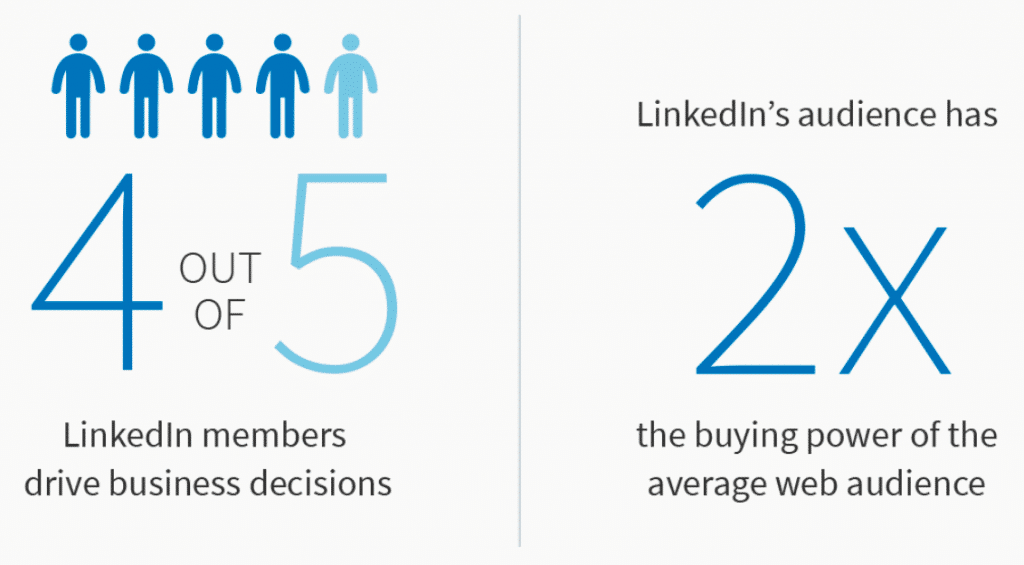
You can implement outreach marketing on LinkedIn by sending cold messages to your 1st-degree contacts or members of any group you belong to. You can also send connection requests with personalized messages.
LinkedIn also offers powerful search options for lead generation. You can use the search filters available to identify the LinkedIn profiles of your potential customers. Premium tools like Sales Navigator help you save prospects as leads and reach out to them via InMails.
As with cold emailing and calling, personalization is the key to a successful LinkedIn outreach campaign.
You can personalize your LinkedIn messages by using first names, company names, and other details that are specific to the person. This will help your message stand out amongst others, especially when reaching out to the person higher up the business hierarchy.
You can take personalization a step further by creating personalized animated GIFs to send to LinkedIn members using Hyperise.

You can use these personalized GIFs in your automated LinkedIn outreach campaigns using tools like Expandi.
LinkedIn automation tools like LinkedCamp, LinkedHelper, Meetalfred, Linkedojet, and SalesRobot can help you automatically reach out to your target audience. Tools like Evaboot help you export leads from LinkedIn Sales Navigator.
3. Social media direct messages
While it is true that LinkedIn is your best bet when it comes to social media outreach, you can also try other social media channels.
Your ideal customer may prefer spending time on Instagram, Facebook groups, or X (formerly Twitter) over LinkedIn. Or you may want to experiment with multiple channels and see which works best.
Either way, the best way to pick a social media channel is to research your target audience. Once you choose a social media channel, you can use different tactics to find these people.
For example, on X (Twitter), you can reach out to people interacting with your competitors’ tweets. On Facebook, you can find groups that match your ideal customer profile and reach out to the group members.
With social media outreach, it is important not to sound too salesy. A quick tip here is to get the conversation going before you pitch your offer. This way, you will seem less intrusive.
4. Multichannel outreach
You can also try a multichannel approach for cold outreach. This method involves reaching out to the same people via different channels. This approach can yield higher sales conversion rates. This is because there are multiple touchpoints with the target audience.
For instance, you can send personalized connection requests to your target audience on LinkedIn. After that, you can contact the same people via email, referring to your conversation on LinkedIn. Another example would be to send a cold email first, followed by a call.
The Ultimate Key to Successful Cold Email Outreach
In this guide, we’ve mentioned a few times that personalization is crucial to a successful cold email outreach campaign. But how do you effectively personalize your cold emails?
The Hyperise toolkit is designed to help businesses like yours personalize their cold emails with images, GIFs, videos, text, and CTAs. With our tool, you can create dynamic content that speaks directly to your prospects, creating a massive impact.
Even one personalized element in your email can make prospects feel like you truly care about them and that you’ve done your research to understand them. This can drive better engagement with your cold emails and get you some big results.
Visit our website to get a free Hyperise demo to experience the power of cold email personalization to boost sales and your bottom line.
Last Updated on September 16, 2025 by Ash